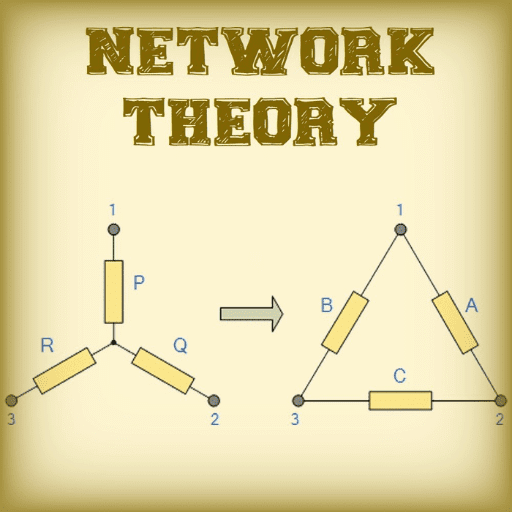Small Signals Modeling of BJT and their Analysis (Part - 1) - Electrical Engineering (EE) PDF Download
Transistor switching networks: Through proper design transistors can be used as switches for computer and control applications.
When the input voltage VB is high ( logic 1), the transistor is in saturation ( ON). And the output at its collector = VCE is almost 0V( Logic 0)
Transistor as a switch
When the base voltage VB is low( logic 0), i.e, 0V, the transistor is cutoff( Off) and IC is 0, drop across RC is 0 and therefore voltage at the collector is VCC.( logic 1) Thus transistor switch operates as an inverter.
This circuit does not require any DC bias at the base of the transistor.
Design
When Vi ( VB) is 5V, transistor is in saturation and ICsat Just before saturation, IB,max = IC,sat / βDC Thus the base current must be greater than IB,max to make the transistor to work in saturation.
Analysis
When Vi = 5V, the resulting level of IB is
IB = (Vi – 0.7) / RB
= ( 5 – 0.7) / 68k = 63mA
ICsat = VCC / RC = 5/0.82k = 6.1mA
Verification
( IC,sat / β) = 48.8mA
Thus IB > ( IC,sat / β) which is required for a transistor to be in saturation.
A transistor can be replaced by a low resistance Rsat when in saturation ( switch on) Rsat = VCE sat/ ICsat (VCE sat is very small and ICsat is IC,max is maximum current)
A transistor can be replaced by a high resistance Rcutoff when in cutoff ( switch on)
Problem
Determine RB and RC for the inverter of figure:
IC sat = VCC / RC
10mA = 10V/ RC
RC = 1kΩ
IB just at saturation = IC sat / β = 10mA / 250 = 40μA
Choose IB> IC sat / β, 60 μA IB = (Vi - 0.7) / RB 60 mA = ( 10 - 0.7) / RB
RB = 155kΩ
Choose RB = 150kΩ, standard value, recalculate IB, we get IB = 62 μA
which is also > IC sat / β Thus, RC = 1k and RB = 155k
Switching Transistors
Transistor „ON‟ time = delay time + Rise time Delay time is the time between the changing state of the input and the beginning of a response at the output.
Rise time is the time from 10% to 90% of the final value.
Transistor „OFF‟ time = Storage time + Fall time
For an „ON‟ transistor, VBE should be around 0.7V
For the transistor to be in active region, VCE is usually about 25% to 75% of VCC. If VCE = almost VCC, probable faults:
– the device is damaged
– connection in the collector – emitter or base – emitter circuit loop is open.
One of the most common mistake in the lab is usage of wrong resistor value. Check various voltages with respect to ground.
Calculate the current values using voltage readings rather than measuring current by breaking the circuit.
Problem – 1
Check the fault in the circuit given.
Problem - 2
PNP transistors
The analysis of PNP transistors follows the same pattern established for NPN transistors. The only difference between the resulting equations for a network in which an npn transistor has been replaced by a pnp transistor is the sign associated with particular quantities.
PNP transistor in an emitter bias
Applying KVL to Input loop:
VCC = IBRB +VBE+IERE
Thus, IB = (VCC – VBE) / [RB + (β+1) RE]
Applying KVL Output loop: VCE = - ( VCC - ICRC)
Bias stabilization
The stability of a system is a measure of the sensitivity of a network to variations in its parameters.
In any amplifier employing a transistor the collector current IC is sensitive to each of the following parameters. b increases with increase in temperature.
Magnitude of VBE decreases about 2.5mV per degree Celsius increase in temperature. ICO doubles in value for every 10 degree Celsius increase in temperature.
Stability factors
S (ICO) = ΔIC / ΔIC0
S (VBE) = ΔIC / ΔVBE
S (β) = ΔIC / Δ β
Networks that are quite stable and relatively insensitive to temperature variations have low stability factors.
The higher the stability factor, the more sensitive is the network to variations in that parameter.
S( ICO)
- Analyze S( ICO) for
– emitter bias configuration
– fixed bias configuration
– Voltage divider configuration
For the emitter bias configuration,
S( ICO) = ( β + 1) [ 1 + RB / RE] / [( β + 1) + RB /
RE] If RB / RE >> ( β + 1) ,
then S( ICO) = ( β + 1)
For RB / RE <<1, S( ICO) 1
Thus, emitter bias configuration is quite stable when the ratio RB / RE is as small as possible.
Emitter bias configuration is least stable when RB / RE approaches ( β + 1) .
Fixed bias configuration
S( ICO) = ( β + 1) [ 1 + RB / RE] / [( β + 1) + RB /
RE] = ( β + 1) [RE + RB] / [( β + 1) RE + RB]
By plugging RE = 0, we get S( ICO) = β + 1
This indicates poor stability.
Voltage divider configuration
S( ICO) = ( β + 1) [ 1 + RB / RE] / [( β + 1) + RB /
RE] Here, replace RB with Rth S( ICO) = ( β + 1) [ 1 + Rth / RE] / [( β + 1) + Rth / RE]
Thus, voltage divider bias configuration is quite stable when the ratio Rth / RE is as small as possible.
Physical impact
In a fixed bias circuit, IC increases due to increase in IC0. [IC = βIB + (β+1) IC0] IB is fixed by VCC and RB. Thus level of IC would continue to rise with temperature - a very unstable situation.
In emitter bias circuit, as IC increases, IE increases, VE increases. Increase in VE reduces IB. IB = [VCC – VBE – VE] / RB. A drop in IB reduces IC.Thus, this configuration is such that there is a reaction to an increase in IC that will tend to oppose the change in bias conditions.
In the DC bias with voltage feedback, as IC increases, voltage across RC increases, thus reducing IB and causing IC to reduce.
The most stable configuration is the voltage – divider network. If the condition βRE >>10R2, the voltage VB will remain fairly constant for changing levels of IC. VBE = VB - VE, as IC increases, VE increases, since VB is constant, VBE drops making IB to fall, which will try to offset the increases level of IC.
S(VBE)
S(VBE) = ΔIC / ΔVBE
For an emitter bias circuit, S(VBE) = - β / [ RB + (β + 1)RE]
If RE =0 in the above equation, we get S(VBE) for a fixed bias circuit as, S(VBE) = - β / RB.
For an emitter bias,
S(VBE) = - β / [ RB + (β + 1)RE] can be rewritten as, S(VBE) = - (β/RE )/ [RB/RE + (β + 1)]
If (β + 1)>> RB/RE, then S(VBE) = - (β/RE )/ (β +
1) = - 1/ RE
The larger the RE, lower the S(VBE) and more stable is the system.
Total effect of all the three parameters on IC can be written as,
ΔIC = S(ICO) ΔICO + S(VBE) ΔVBE + S(β)Δβ
General conclusion: The ratio RB / RE or Rth / RE should be as small as possible considering all aspects of design.
Transistor at low frequencies
- Introduction
- Amplification in the AC domain
- BJT transistor modeling
- The re Transistor Model
- The Hybrid equivalent Model
Introduction
- There are three models commonly used in the small – signal ac analysis of transistor networks:
- The re model
- The hybrid p model
- The hybrid equivalent model
Amplification in the AC domain
The transistor can be employed as an amplifying device, that is, the output ac power is greater than the input ac power. The factor that permits an ac power output greater than the input ac power is the applied DC power. The amplifier is initially biased for the required DC voltages and currents. Then the ac to be amplified is given as input to the amplifier. If the applied ac exceeds the limit set by dc level, clipping of the peak region will result in the output. Thus, proper (faithful) amplification design requires that the dc and ac components be sensitive to each other‟s requirements and limitations. The superposition theorem is applicable for the analysis and design of the dc and ac components of a BJT network, permitting the separation of the analysis of the dc and ac responses of the system.
BJT Transistor modeling
- The key to transistor small-signal analysis is the use of the equivalent circuits (models). A MODEL IS A COMBINATION OF CIRCUIT ELEMENTS LIKE VOLTAGE OR CURRENT SOURCES, RESISTORS, CAPACITORS etc, that best approximates the behavior of a device under specific operating conditions. Once the model (ac equivalent circuit) is determined, the schematic symbol for the device can be replaced by the equivalent circuit and the basic methods of circuit analysis applied to determine the desired quantities of the network.
- Hybrid equivalent network – employed initially.
Drawback – It is defined for a set of operating conditions that might not match the actual operating conditions. - re model: desirable, but does not include feedback term
- Hybrid p model: model of choice.
AC equivalent of a network
- AC equivalent of a network is obtained by:
- Setting all dc sources to zero and replacing them by a short – circuit equivalent
- Replacing all capacitors by short – circuit equivalent
- Removing all elements bypassed by the short – circuit equivalents
- Redrawing the network in a more convenient and logical form.
re model
- In re model, the transistor action has been replaced by a single diode between emitter and base terminals and a controlled current source between base and collector terminals.
- This is rather a simple equivalent circuit for a device
FAQs on Small Signals Modeling of BJT and their Analysis (Part - 1) - Electrical Engineering (EE)
| 1. What is small signal modeling of a BJT? |  |
| 2. Why is small signal modeling important in BJT analysis? |  |
| 3. What are the key assumptions made in small signal modeling of a BJT? |  |
| 4. How is small signal modeling performed for a BJT? |  |
| 5. What are the limitations of small signal modeling in BJT analysis? |  |






























